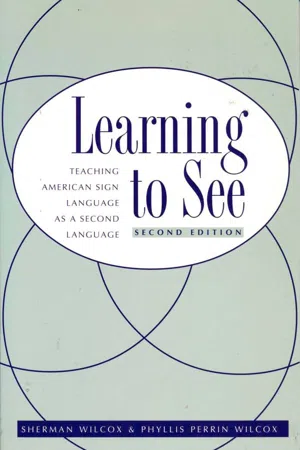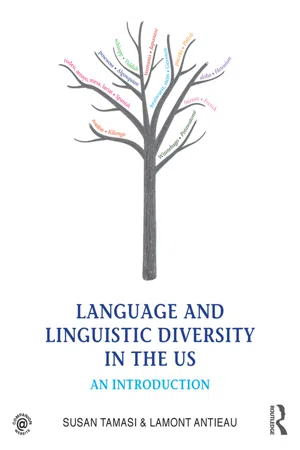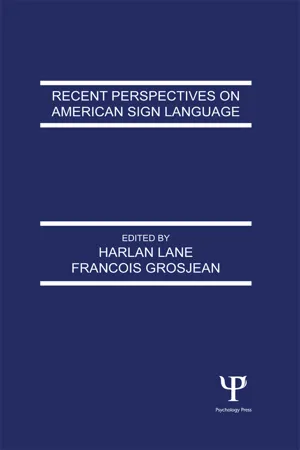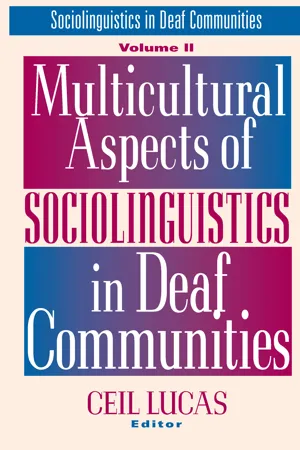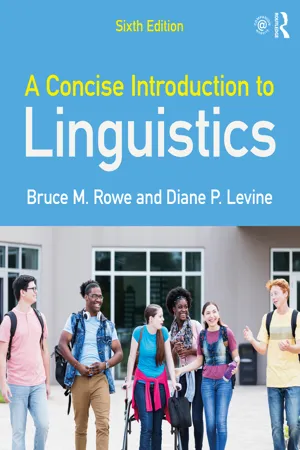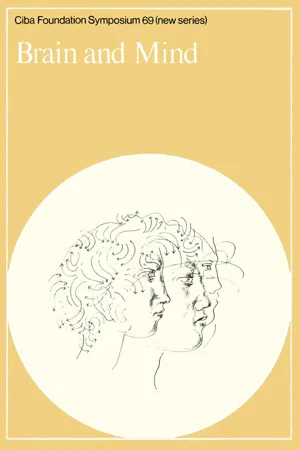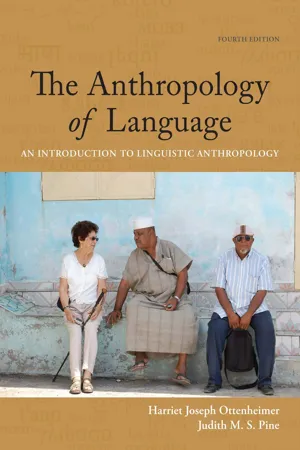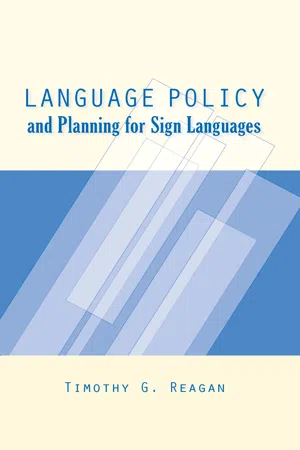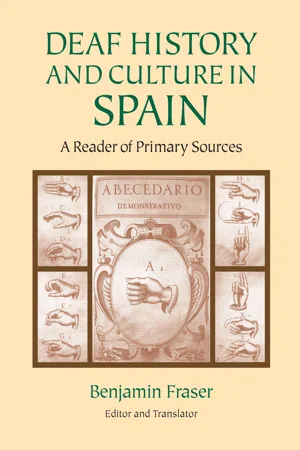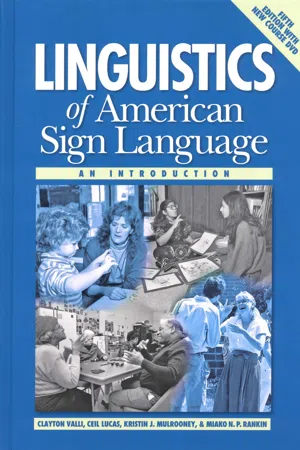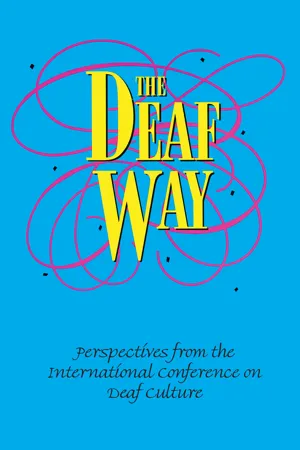Languages & Linguistics
ASL
ASL, or American Sign Language, is a visual-gestural language used by Deaf and hard of hearing individuals in the United States and parts of Canada. It has its own grammar, syntax, and vocabulary, and is a distinct language from English. ASL is a rich and complex language that allows for nuanced communication through handshapes, movements, and facial expressions.
Written by Perlego with AI-assistance
Related key terms
1 of 5
12 Key excerpts on "ASL"
- eBook - PDF
Learning To See
American Sign Language as a Second Language
- Sherman Wilcox, Phyllis Perrin Wilcox(Authors)
- 2014(Publication Date)
- Gallaudet University Press(Publisher)
13 2 American Sign Language in Perspective A Short History of ASL American Sign Language (ASL) is the visual/gestural lan-guage that serves as the primary means of communication of deaf people in the United States and parts of Canada. It is difficult to extrapolate the size of the deaf population because the United States Bureau of the Census has not included a question on hear-ing loss since the national survey in 1930. In 1974 the National Association of the Deaf, in cooperation with the Deafness Re-search and Training Center at New York University, conducted a special census of the deaf population. There has been a lack of consensus regarding the definition of deafness and how to deter-mine who is deaf or hard of hearing. The National Center for Health Statistics estimates that there are perhaps 20 million per-sons with a hearing loss, with approximately 550,000 persons with the ‘‘inability to hear and understand speech’’ (Holt and Hotto 1994, 2). In 1987, Padden estimated that between 100,000 and 500,000 people use ASL. This estimate included native sign-ers who learned ASL as their first language from deaf parents, hearing children of deaf parents who also learned ASL as their native language, and fluent signers who have learned ASL from deaf people. In the past decade, thousands of additional students in universities and educational settings have begun acquiring ASL. The number of ASL users continues to grow yearly. The history of ASL is long and rich. Much of its early develop-ment, however, remains poorly documented. One reason for this 14 American Sign Language in Perspective is that, as in the case of spoken languages, the early forms of signed languages are not preserved. Research can establish the time and circumstances under which education and formal in-struction in English and in various forms of signing were brought to deaf people in the United States, but little is known about the structure of the language that deaf people used prior to this. - eBook - ePub
Language and Linguistic Diversity in the US
An Introduction
- Susan Tamasi, Lamont Antieau(Authors)
- 2014(Publication Date)
- Routledge(Publisher)
14 American Sign LanguageGUIDING QUESTIONS1. Where and how did American Sign Language (ASL) begin?2. What is the structure of American Sign Language?3. Who uses American Sign Language?4. What is the relationship between ASL and American Deaf culture?5. What is the connection between ASL and English?OVERVIEWThis chapter examines the creation and development of a sign language for America’s Deaf community. It discusses and details the structure of the language, including dialectal variation, and looks at the history of its use (or disuse) within the American educational system. It also presents social issues and controversies within the Deaf community, such as the debate over the use of cochlear implants.COMMON MYTHSThere is one universal sign language used by all deaf people.ASL is not a language but simply a series of gestures.Sign language is simply fingerspelling.ASL is a signed version of English.ASL signs mimic the shape or action of the noun or verb.INTRODUCTIONIn Chapter 1 , we defined language as “an open, arbitrary, conventional system of sounds used for communication within a linguistic community,” but this definition overlooks the fact that while most languages are spoken, some are articulated through nonverbal signs. Except for the mode of transmission—spoken languages utilize auditory processes, whereas sign languages comprise complex visual-spatial structures (National Association of the Deaf, 2008)—all other aspects of our definition of language apply to signing. All sign languages are individual, complex systems in their own right, with their own grammars, their own lexicons, and their own pragmatic rules. They change and vary, and they are generally not mutually intelligible with other sign (or spoken) languages. Crucially, they are not simply gestured versions of spoken languages. And significantly, like spoken languages, they are intimately related to the identities of the communities that use them. In other words, languages transmitted through signs are in every way equal to spoken languages and, as such, we must expand our definition of language - eBook - ePub
- Harlan L. Lane, Francois Grosjean(Authors)
- 2017(Publication Date)
- Psychology Press(Publisher)
2The Linguistic Description of American Sign LanguageRonnie WilburBoston UniversityIntroduction
Recent studies of American Sign Language (ASL) have argued convincingly that ASL is a language in the full linguistic sense of the word. Research into the structrue of ASL began in earnest with Stokoe (1960), and only recently have the details of ASL acquisition, memory, perception, history, sociology, and educational implications been approached. Recent research in linguistics illustrates the variety of topics that has been investigated: sociolinguistics (Woodward, 1973a, 1973b, 1973c), historical changes (Frishberg, 1976), phonology (Friedman, 1976a, 1976b), syntax (Liddell, 1977), borrowings from English through fingerspelling (Battison, 1978), the pronoun system (Lacy, personal communication; Kegl, 1976a, 1976b, 1977), and the complete range of systems built on the indexic pointing gesture and their acquisition (Hoffmeister, 1978a, 1978b). These and other studies have highlighted many linguistic features of ASL. Extensive research on other sign languages has not yet been conducted. Of necessity then, this chapter focuses entirely on ASL. It may be presumed that many of the processes, if not the actual details, will be found in other sign languages when they are investigated.Phonology
Stokoe (1960) investigated sign formation, which he called “cherology,” treating it as analogous to the phonological system of oral languages. He defined three parameters that were realized simultaneously in the formation of a particular sign—DEZ (designator, handshape), TAB (Tabulation, location), and SIG (signation, motion). A fourth parameter, ORIENTATION, which refers to the orientation of the palm, was added later by Battison (1973; Battison, Markowicz, & Woodward, 1975). In oral languages, distinctive features are simultaneously combined to produce consonantal and vocalic segments. Analogously, the four Stokoe parameters are produced simultaneously to form signs. - Ceil Lucas(Author)
- 2014(Publication Date)
- Gallaudet University Press(Publisher)
2. In 196o, William C. Stokoe published the first linguistic study of ASL (Sign Lallguage Structure: All Outline of the Visual Communicatio/l Systems of tlie American Deaf Baker and Battison 1980). The Case for ASL as a Truly Foreign Language 183 then "about like learning Spanish" or "about like learning Greek" or "about like learning Swahili" or "about like learning Chinese"? The fo- cus of this chapter is on the concept of "degree of foreignness." If ASL is to be considered a foreign language, just how foreign is it from En- glish? And what are the implications of its degree of foreignness on its placement within academic programs, the length and structure of those programs, the instructors who teach ASL, and the training of interpret- ers who work between ASL and spoken English? For the reader who is unfamiliar with ASL and signed languages, I will point out that there is a great difference between knowing how to sign or learning signs-and learning/knowing ASL. Many people, par- ticularly those who have learned to sign as adults, both hearing and deaf, learn the vocabulary, the signs of American Sign Language, and restruc- ture the syntax so the signs follow English word order. This type of sign- ing, known by such terms as English-based signing 3 or, by some linguists, as contact signing,4 is quite common and often accomplishes the intended purpose, that is, some type of communication or information sharing, but it is not American Sign Language. This description is a simplistic men- tion of a very complex subject, and many people use this type of signing as their primary means of communication. However, for our purposes, I refer to American Sign Language, a natural language that is structurally and grammatically very different from English, and to American Deaf culture (ADC), the culture of the American community of users of ASL.- eBook - ePub
- Bruce M. Rowe, Diane P. Levine(Authors)
- 2022(Publication Date)
- Routledge(Publisher)
fingerspelling, different hand shapes represent different letters of the alphabet. Words of an oral language can be spelled directly.ASL, English, and other systemsFIGURE11.2ASL is not based on English. Contact sign, like any pidgin, is a combination of forms from more than one language. In this case, the languages are ASL and English. As we move upward on the right side of the diagram, the signing systems become increasingly influenced by English.Fingerspelling: American Manual Alphabet and selected numbersFIGURE11.3Unlike MCE and fingerspelling, ASL is a completely different language than English. It is not based on English or any other oral language. Modern ASL originated in the 1800s as a combination of French Sign Language and early indigenous sign language in the United States (see Box 11.1 ).ASL signs often have only approximate English translations and vice versa. Even for words that do translate closely from ASL to English, the forms of the resulting utterances in the two languages are different. For example, the ASL sign sequence that would have the word-for-sign translation ofFINISH TOUCH EUROPE?is a grammatically correct ASL sentence. This is not proper English word order, nor is the meaning of the sequence completely obvious. As represented in English, that meaning isHave you been to Europe?33 Dennis Cokely, “Foreword,” in Harry W. Hoemann, American Sign Language: Lexical and Grammatical Notes with Translation Exercises (Silver Spring, MD: National Association of the Deaf, 1976).ASL is a complexly structured language with its own grammar. It displays the fundamental properties linguists have described for all languages. ASL is the native language of hundreds of thousands of deaf people in the United States and Canada. Unlike MCE and fingerspelling, which are usually used in educational settings and for public communication with hearing people, ASL has historically been used almost exclusively within the Deaf community. For native signers of ASL, the encoding and decoding of their language operate without any link to English. - eBook - PDF
- G. E. W. Wolstenholme, Maeve O'Connor(Authors)
- 2009(Publication Date)
- Wiley(Publisher)
At the beginning of our research, some eight years ago, we did not know whether ASL was an independent language, nor precisely how that concept might apply to gestural communication. The available literature generally stressed the icon and image behind the global form of signs. We read that sign language is ‘a collection of vague and loosely defined pictorial gestures’; that it is a ‘universal’ communication; that it is pantomime; that it is ‘much too much a depicting language, keeping the thinking slow’; that ‘sign language deals mainly with material objects, dreads and avoids the abstract’; that it is ‘derived from English, a pidgin form of English on the hands with no structure of its own’. We were then faced with a communication system that appeared totally different from speech and spoken language, a communication system that apparently violated some of the putative universal characteristics posited for human language: that language is based on speech and the vocal apparatus; that linguistic symbols are essentially arbitrary, the form of a symbol bearing no relation to the form of its referent. What aroused our interest was the opportunity to study a language that had developed fully in an unexpected and different mode. Since that time, our investigations have covered a wide array of concerns: the linguistic structure of the sign ; iconicity in signs and signing; historical change in signs; immediate and long-term memory for signs; comparison between two independent sign languages; perception of signs; studies of slips of the hand; the role of non-manual signals in the language; studies of ASL syntactic processes; studies of the rate of production of sign language and spoken language; studies of grammatical processes such as compounding, derivational and inflectional processes; studies of invented or recently coined - eBook - PDF
The Anthropology of Language
An Introduction to Linguistic Anthropology
- Harriet Ottenheimer, Judith Pine(Authors)
- 2018(Publication Date)
- Cengage Learning EMEA(Publisher)
Stokoe persisted, however, and in 1960 he published Sign Language Structure , in which he presented a groundbreakingly thorough analysis of the phonology, morphology, and syntax of American Sign Language. He also presented a brief history of the language. The History of American Sign Language American Sign Language (commonly abbreviated as ASL ) was origi-nally developed from French Sign Language. French Sign Language was brought to the United States in 1816 by Thomas Gallaudet, a grad-uate of Yale University, and Laurent Clerc, a French graduate of the Paris School for the Deaf. Working together, Gallaudet and Clerc began to mold French Sign Language into a new American system. Some tantalizing new research suggests that indigenous sign languages of the northeastern United States also contributed to the early develop-ment of American Sign (Davis 2010). Gallaudet and Clerc began teach-ing their system to students at the American Asylum at Hartford, Connecticut, the first school for deaf people in the United States. At first called Old Signed English , it is now referred to as American Sign Language. Because it is based on French Sign Language (and perhaps because it also incorporates some elements from indigenous sign languages), American Sign Language is completely different from British Sign Language; the signs are different, the grammati-cal bases are different, and the two languages are mutually unintel-ligible. You could say that American Sign Language and British Sign Language are as different from one another as spoken English is from spoken Japanese. Copyright 2019 Cengage Learning. All Rights Reserved. May not be copied, scanned, or duplicated, in whole or in part. Due to electronic rights, some third party content may be suppressed from the eBook and/or eChapter(s). Editorial review has deemed that any suppressed content does not materially affect the overall learning experience. - Timothy G. Reagan(Author)
- 2014(Publication Date)
- Gallaudet University Press(Publisher)
THE BACKGROUND TO THE TWENTIETH CENTURY: THE LEGITIMATION OF ASL For the first half of the twentieth century, ASL was not thought of as a “legitimate” language at all. Characteristic of the general view of ASL was Myklebust’s assertion that “sign language cannot be considered comparable to a verbal symbol system” (1964, p. 158, quoted in Lane, 112 : c h a p t e r 3 1992, p. 45), and, more recently, the claim that “the informative power of the natural sign language of the deaf is extremely weak” (van Uden, 1986, p. 89). Such views were not only far from uncommon, they were the norm. Indeed, Myklebust’s view about the limits of sign language was even stronger than this might suggest; in the 1957 version of his book The Psychology of Deafness , he wrote, “The manual language used by the deaf is an ideographic language . . . it is more pictorial, less symbolic. . . . Ideographic language systems, in comparison with verbal systems, lack precision, subtlety, and flexibility. It is likely that Man can-not achieve his ultimate potential through an Ideographic language . . . The manual sign language must be viewed as inferior to the verbal as a language” (1957, pp. 241–42). As late as 1980 he wrote, “American Sign Language is often described in the following ways: It is a universal language whose grammar is poor compared to that of spoken language; its vocabulary is concrete and iconic; it consists of gestures accompanied by facial expressions” (Markowicz, 1980, p. 1). As mentioned in passing in Chapter 1, the work of a single individ-ual radically changed all of this. William Stokoe was a junior faculty member in the English Department at Gallaudet College (now Gallaudet University) when he published his monograph Sign Language Structure in 1960.- eBook - PDF
- Diane Brentari(Author)
- 2019(Publication Date)
- Cambridge University Press(Publisher)
The answer is “yes, it does,” but this question lingers because the medium is so unfamiliar. For the purposes of this volume, a sign language is any one of the more than 200 known manual languages used in the deaf 1 commu- nities of the world. They are produced on the hands, as well as on the face and body. They are shared within a community, they are passed down from one generation to the next, and they serve all of the linguistic and cultural functions that one would expect of a language. If there is a system used for limited purposes, or as a surrogate for speech, it is not included within this designation. An 1 A comment is needed here about the use of “Deaf” versus “deaf” in this book. “Deaf” has been used for several decades when discussing the cultural identity of an individual or community, and “deaf” when discussing the biological definition of hearing loss. I will follow Kusters’ (2017) rationale and use “deaf” for all kinds of deaf people in this book. The “D/d” distinction is still important, but as deaf people from an ever wider range of backgrounds are included in academic discourse, the range of terms will become more nuanced, and the binary distinc- tion D/d may not always be appropriate. Instead, groups of signers will therefore be described in prose as they arise. 2 introduction example of such a surrogate system (not a natural sign language) is the one used in the Walpiri community by hearing women who grew up speaking Walpiri. They use a manually coded version of spoken Walpiri during their rather long period of mourning after they become widows (Kendon, 1980, 1984, 1985, 1987, 1988). Other such systems include manually coded systems of spoken languages throughout the world – e.g., Signed English, Signed French, Signed German, Signed Italian. - eBook - PDF
Deaf History and Culture in Spain
A Reader of Primary Documents
- Benjamin Fraser(Author)
- 2009(Publication Date)
- Gallaudet University Press(Publisher)
By means of a series of photo-graphs, charts, and pictures, the Danish deaf people made interesting observations about their communication. Regarding sign language, they declared that “it is a distinct language,” “it is the spoken language of deaf people,” “it has many dialects,” “it possesses its own grammar,” “it has no written form,” “it possesses more than six thousand signs,” “it is a living language that changes over time,” “it is an oppressed language,” and “it is necessary for deaf people” (in the publication Réeducation Orthophonique [Paris], 1977, vol. 15, no. 98, p. 528). Finally, we strongly urge continuing the investigation of sign lan-guage, because, certainly, by delving into the study of a language, more can be learned about those who use it; and, also, so that the novel con-tributions to the study of gestural language might fill a large blind spot in linguistic studies in Spain, which, in turn, being so fruitful elsewhere, might also contribute to the enrichment of linguistic science and semi-otics in general. Bibliography Alarcos, E. 1968. L’acquisition du langage par l’enfant,” in Traité du langage , ed. A. Martinet. Repr. with Spanish trans., 9–42. Buenos Aires: Nueva Visión, 1976. Anderson, L. B. 1979. “Aspect in sign language morphology: The role of universal semantics and pragmatics in determining grammatical categories.” Washington, DC: Linguistic Research Laboratory, Gallaudet College. Ashbrook, E., and E. Newport. 1977. “The emergence of semantic relations in American Sign Language.” Papers and Reports on Child Language Development 13:16–21. 242 DEAF HISTORY AND CULTURE IN SPAIN Bellugi, U., and E. Klima. 1972. “The roots of language in the sign talk of the deaf.” Psy-chology Today 6:661–76. Bouillon, J. P. 1979. “Compte Rendu d’une visite au Gallaudet College” (21 Juillet-5 Août 1978). Revue générale de l’enseignement des déficients auditifs 2:56–78. Buyssens, E. 1967. La communication et l’articulation linguistique . - eBook - PDF
Linguistics of American Sign Language, 5th Ed.
An Introduction
- Clayton Valli, Ceil Lucas, Kristin J. Mulrooney, Miako Villanueva(Authors)
- 2020(Publication Date)
- Gallaudet University Press(Publisher)
Interpret- ing 1 (1): 39–67. Smith, D., and Ramsey, C. 2004. Classroom discourse practices of a deaf teacher using American Sign Language. Sign Language Studies 5 (1): 39–62. Taub, S., Galvan, D., and Pinar, P 2009. The role of gesture in cross-modal typological studies. Cogni- tive Linguistics 20 (1): 71–92. Winston, E. A. 1993. Spatial mapping in comparative discourse frames in an ASL lecture. Ph.D. diss., Georgetown University. ———, ed. 1999. Storytelling and conversation: Discourse in Deaf communities. Sociolinguistics in Deaf Communities, vol. 5. Washington, DC: Gallaudet University Press. van Hoek, K. 1996. Conceptual locations for reference in American Sign Language. In Spaces, worlds, and grammar, ed. G. Fauconnier and E. Sweetser, 334–350. Chicago: University of Chicago Press. Volterra, V., and Erting, C., eds. 1994. From gesture to language in hearing and deaf children. Wash- ington, DC: Gallaudet University Press. Zimmer, J. 1989. Toward a description of register variation in American Sign Language. In The socio- linguistics of the deaf community, ed. C. Lucas, 253–272. San Diego: Academic Press. 186 Language in Use Homework Assignment 19 1. You are walking along and you see a group of your friends talking. You want to join the conversation. Think about and describe how you enter the group and how you get a turn to talk. What signs do you use? What about eye gaze? What is the correct way to enter a conversation and what is the “wrong” way? 2. What do you do in an ASL conversation when you want to change the topic? What signs do you use? Is there a particular way to change the subject? 3. Make a list of five signs that are signed differently in formal and informal situations, and describe how they differ. For example, KNOW may differ depending on the setting. 4. Watch a conversation from the Kansas or Louisiana segments of the DVD. Identify what signers do to indicate they want to take the floor. - eBook - PDF
The Deaf Way
Perspectives from the International Conference on Deaf Culture
- Carol J. Erting, Robert C. Johnson, Dorothy L. Smith, Bruce C. Snider, Carol J. Erting, Robert C. Johnson, Dorothy L. Smith, Bruce C. Snider(Authors)
- 2009(Publication Date)
- Gallaudet University Press(Publisher)
All too often this appears to be done, and to us this does not seem to do justice to the complexity of perceiving sign language-or anything for that matter. Finally, we have addressed the subject of German Sign Language because it is a language we have researched over the last three years. Whether anything that has been said can be applied to other sign languages remains to be seen. I would urge students of other sign languages, however, to pay attention not only to the way sign language makes language visible through manual and nonmanual elements, but also to how it gives meaning even to those elusive movements of the lips and tongue. Seen in this German Words in German Sign Language light, recognizing words in a sign language is yet another tribute to the great creativity and ingenuity of deaf people. References Gregory, R. L. 1987. The Oxford Companion to the Mind. New York: Oxford University Press. p. 599. Schermer, T. M. 1985. "Analysis of Natural Discourse of Deaf Adults in the Netherlands: Observations on Dutch Sign Language." In SLR '83: Proceedings of the Third Inter- national Symposium on Sign Language Research, ed. W. Stokoe and V. Volterra. Silver Spring, MD: Linstok Press and Rome, Italy: Istituto di Psicologia. pp. 281-288. Schroeder, Odd-Inge. 1985. "A Problem in Phonological Description." In SLR '83: Pro- ceedings of the Third International Symposium on Sign Language Research, ed. W. Stokoe and V. Volterra. Silver Spring, MD: Linstok Press and Rome, Italy: Istituto di Psico- logia. pp. 194-201. 409 THE DEAF WAY ANNA FOLCHI he objective of my work is to compile as comprehensive a collection as pos- sible of Italian signs. However, I am still far from this goal because of the large number of Italian signs. Originally, my purpose was to prepare a dic- tionary of sign language, but it seems to me now that the planned dictionary could become, rather, an encyclopedia, which would take years of work and research.
Index pages curate the most relevant extracts from our library of academic textbooks. They’ve been created using an in-house natural language model (NLM), each adding context and meaning to key research topics.
